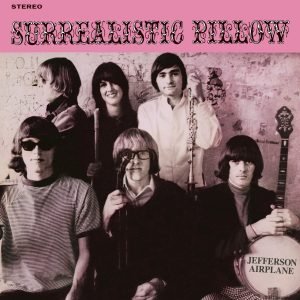When Jefferson Airplane released Surrealistic Pillow in 1967, it marked a turning point not only for the band but also for the sound of American rock. Their first album, Jefferson Airplane Takes Off, leaned heavily on folk-rock traditions. By contrast, Surrealistic Pillow pushed into more experimental territory, embracing the psychedelic currents that were beginning to shape the music scene in San Francisco and beyond.
This album arrived at a time when music was evolving rapidly, and the Airplane was ready to evolve with it. They had just welcomed two key new members: Grace Slick, whose commanding vocals became central to their identity, and Spencer Dryden, who brought a jazz-influenced drumming style that gave their rhythms more texture. With this refreshed lineup, the band seemed determined to both challenge themselves artistically and capture the spirit of a cultural movement in full swing.
Sonic Exploration

One of the most striking aspects of Surrealistic Pillow is how its sound manages to feel both of its time and strangely timeless. The production, overseen by Rick Jarrard, leans toward warmth and clarity without stripping away the rawness that gives the album its soul. The sound isn’t overly polished, but it avoids the muddiness that sometimes mars late-sixties recordings. Instruments are well-separated in the mix, allowing each part—from the jangling guitars to the layered harmonies—to breathe. This clarity is especially noticeable on the quieter tracks, where acoustic textures and vocal subtleties come through with surprising depth.
The arrangements are where the album truly stretches its wings. There’s a thoughtful balance between structure and spontaneity. On “White Rabbit,” the ascending structure mirrors the lyrical build-up, creating a hypnotic, almost cinematic arc. “Embryonic Journey,” a solo guitar piece by Jorma Kaukonen, offers a completely different palette—a reflective, fingerpicked instrumental that feels both meditative and exploratory. Elsewhere, the vocal interplay between Marty Balin and Grace Slick gives songs like “Today” and “She Has Funny Cars” an emotional and textural richness that elevates even simple melodies.
Musically, Surrealistic Pillow straddles several genres. Folk-rock remains a core ingredient, with echoes of their earlier work still present. But the band dives headfirst into psychedelia, adding swirling guitar effects, modal melodies, and cryptic lyrics that push the boundaries of pop and rock conventions. Tracks like “3/5 of a Mile in 10 Seconds” touch on bluesy garage rock, while others flirt with baroque pop and even proto-prog in their ambitious structures. What makes it work is the cohesion—the band doesn’t just dabble in these genres, they blend them into a sound that feels uniquely their own.
Lyrical Analysis

Lyrically, Surrealistic Pillow captures the mood of a generation standing at the edge of transformation. The album weaves together themes of desire, freedom, alienation, and consciousness, often through a lens that’s both dreamlike and questioning. It’s less concerned with telling linear stories and more focused on evoking states of mind—whether it’s the heady rush of new love, the quiet ache of introspection, or the surreal pull of altered perception.
One of the most prominent lyrical themes is the search for meaning beyond the everyday. “White Rabbit” stands out not just for its bold structure, but for how it taps into the era’s curiosity about the inner mind and the limits of control. Drawing on references to Alice in Wonderland, Grace Slick crafts a surreal parable about following one’s curiosity, even when it leads into strange or challenging places. Meanwhile, “Somebody to Love” channels a more urgent, emotional energy. Its message is simple—don’t waste time on falsehood or hesitation—but it’s delivered with enough force and clarity to resonate deeply.
Lyrical Depth
Across the album, there’s a noticeable mix of abstract and direct writing. Marty Balin’s lyrics often lean toward emotional vulnerability, as seen in “Today” and “Coming Back to Me.” These songs use plain language, yet they carry a heavy emotional weight, creating moments of calm amid the album’s more psychedelic flourishes. In contrast, tracks like “Plastic Fantastic Lover” are more cryptic, mixing social critique with rapid-fire phrasing that leaves room for multiple interpretations.
While not every line on the album is dense with meaning, the lyrics generally do a fine job of supporting the mood and message of each song. They aren’t overly ornate, but that works in the album’s favor. The simplicity in some places allows the emotional core to shine through, while the more abstract tracks invite listeners to find their own meaning.
Cohesion and Flow

One of the quiet strengths of Surrealistic Pillow is how smoothly its songs unfold, despite the variety in mood and style. From the opening bars of “She Has Funny Cars” to the final echoes of “Plastic Fantastic Lover,” the album maintains a thoughtful pacing that helps guide the listener through its shifting emotional terrain. There’s no rigid storyline here, but the arrangement of tracks suggests a journey—one that moves through moments of questioning, passion, reflection, and release.
The track progression feels intentional. High-energy songs like “Somebody to Love” are balanced by more introspective moments such as “Today” and “Comin’ Back to Me.” These shifts are handled with enough care that they feel natural rather than abrupt. Instrumentals like “Embryonic Journey” serve as welcome pauses, creating space for the listener to absorb what came before and reset for what’s ahead. Even the more electric, fast-paced tracks avoid disrupting the flow. Instead, they inject momentum at just the right points.
Thematically, the album remains remarkably consistent. Even as it dips into different sonic textures—folk, psychedelic rock, baroque flourishes—the emotional core holds steady. The lyrics repeatedly return to themes of longing, perception, and emotional honesty. This unity is reinforced by the vocal presence of both Marty Balin and Grace Slick, whose contrasting but complementary styles help anchor the album’s tone.
That said, there are a few moments where the cohesion strains slightly. For example, “Plastic Fantastic Lover,” with its sharp energy and satirical edge, closes the album on a somewhat dissonant note. It’s a strong track on its own, but its placement might feel abrupt after the more serene and poetic mood of earlier songs. Still, these moments are rare, and they don’t derail the overall sense of flow.
Standout Tracks and Moments
While Surrealistic Pillow is a strong and cohesive album as a whole, several tracks rise above the rest, either through their emotional pull, bold experimentation, or sheer musical power. These standout moments not only define the album—they help explain its enduring influence.
White Rabbit
“White Rabbit” is perhaps the album’s most iconic track, and for good reason. With its slow, escalating build and hypnotic delivery, the song captures the spirit of late-sixties psychedelia in under three minutes. Grace Slick’s voice moves from a whisper to a command, layering myth, literature, and subtext in a way that still feels daring today. Its use of a bolero-like rhythm adds an almost classical drama, making the final chorus feel like a peak in both sound and meaning.
Somebody to Love
“Somebody to Love” stands out for different reasons. It’s more direct, emotionally charged, and rhythmically driving. Slick’s lead vocal here is fierce and urgent, turning a song about love and disconnection into a rallying cry. It’s not just a highlight of the album—it’s one of the most electrifying performances of the era.
Today & Comin’ Back to Me
On the more reflective side, “Today” and “Comin’ Back to Me” show the band’s quieter strengths. “Today” is a soft, aching ballad led by Marty Balin, whose restrained vocals give the song a fragile beauty. “Comin’ Back to Me,” with its slow pace and echoing instrumentation, feels suspended in time, evoking longing in a way that’s both intimate and atmospheric.
Embryonic Journey
A surprising standout is “Embryonic Journey,” the instrumental piece by Jorma Kaukonen. In just over a minute and a half, the track offers a pure, unfiltered moment of acoustic brilliance. Its intricate fingerpicking and reflective tone provide a welcome shift in texture, highlighting the band’s versatility and musical skill.
3/5 of a Mile in 10 Seconds
Among the more electrified tracks, “3/5 of a Mile in 10 Seconds” delivers a punch of garage-rock energy, with its rapid lyrics and gritty guitar work. It may not be as well-known as the hits, but it captures the band’s rawer, more rebellious side.
Memorable Moments
There are also subtle moments that showcase the band’s talent. The layered harmonies in “She Has Funny Cars,” the dreamy reverb on “How Do You Feel,” and the sudden vocal hush at the end of “Today” are all small but effective touches that add emotional and musical depth. These details, often tucked between the more obvious highlights, help give the album its lasting charm.
Artistic Contribution and Innovation

When Surrealistic Pillow arrived in early 1967, it wasn’t just another rock album—it was part of a cultural turning point. Jefferson Airplane helped give shape to the psychedelic rock movement, not by abandoning traditional forms entirely, but by fusing them with something deeper, stranger, and more emotionally charged. In doing so, the album carved out a space between the folk revival of the early sixties and the more experimental rock that would dominate the decade’s second half.
Within the genre, Surrealistic Pillow occupies a foundational spot. While bands like The Byrds and The Beatles were also exploring psychedelic elements, Jefferson Airplane leaned into that aesthetic in a way that felt more direct and less polished. They weren’t content to just add sitars or echo effects—they wanted the entire mood of their music to feel dreamlike, confrontational, or even unsettling. This boldness helped set the tone for the West Coast sound and positioned the band as leaders of the San Francisco scene.
Innovation
What stands out most in terms of innovation is how the band managed to blend accessibility with experimentation. Tracks like “Somebody to Love” and “White Rabbit” became radio staples, but they didn’t follow the typical pop song formula. Whether it was Grace Slick’s operatic delivery, the modal structures borrowed from classical and Eastern music, or the layered harmonies that bent genre lines, the album constantly pushed its boundaries while still resonating with a wide audience.
The production itself also deserves credit. Though recorded quickly and on a modest budget, the album has a surprisingly rich sound. Rick Jarrard’s approach was not overly fussy, which allowed the natural textures of the performances to shine through. This choice gave the record an immediacy that still holds up—clear enough to feel deliberate, raw enough to feel alive.
Lyrically, the album also took risks. Instead of sticking to love songs or simple narratives, it explored altered states of mind, emotional dislocation, and spiritual searching. This was still rare in mainstream rock at the time, and it signaled a shift toward more introspective and abstract songwriting in popular music.
Closing Thoughts

Surrealistic Pillow stands as a landmark album that captures the spirit of its time without feeling locked within it. Its strengths are many: a bold fusion of folk, rock, and psychedelia; compelling, emotionally varied lyrics; standout performances from Grace Slick, Marty Balin, and the rest of the band; and a production style that enhances rather than overpowers the music. From soaring anthems to hushed reflections, the album shows a group willing to explore the full spectrum of sound and emotion.
It’s not without its weaknesses. A few moments near the end can feel less polished or thematically cohesive, and some listeners might find the abrupt stylistic shifts a bit jarring. However, these minor issues don’t overshadow the album’s achievements. If anything, they underscore its willingness to take creative risks—something that’s part of its enduring charm.
In terms of its legacy, Surrealistic Pillow helped define the sound of late-60s counterculture while also expanding the possibilities of rock music. It’s an album that speaks to both the moment it was born in and the many that came after.
Official Rating: 9/10
This score reflects both the album’s historical significance and its artistic impact. It’s not a perfect record, but it comes remarkably close—bold, inventive, and emotionally resonant. For anyone exploring the roots of psychedelic rock or the evolution of American music in the sixties, Surrealistic Pillow remains essential listening.
